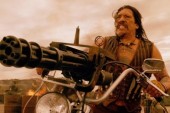
A film adaptation of Ender’s Game is finally seeing a release this fall. After spending years languishing in development at Warner Bros., the studio’s rights to the popular science fiction book lapsed and the property finally moved forward with a new studio, Summit. But a change in studios hasn’t solved all of the problems in adapting this novel.
In order to bring this cult favourite to the screen, producers tapped Gavin Hood, who most recently directed X-Men Origins: Wolverine (as opposed to James Mangold’s The Wolverine, released earlier this summer), but previously won an Academy Award for Best Foreign Language film for Tsotsi, a critically praised South African drama about a gangster who accidentally steals a car with a baby in the backseat.
Unfortunately for Hood, who both wrote and directed the adaptation, the author of the book, Orson Scott Card, has been very public about his views on homosexuality and his opposition to same-sex marriage, miring the film in a controversy and potential boycott that Hood would rather avoid. I had a chance to sit down with Hood while he was in town this weekend promoting the film at Fan Expo. We talked about his attachment to the material, the challenges of making a blockbuster, and his frustrations with Card’s political opinions.
On top of directing Ender’s Game, you also wrote the screenplay, which is unusual on a film of this scale. Is this because you have a personal attachment to the project?
I do. I spent time in the military myself when I was seventeen. I was in for two years, I was drafted. It was a very unsettling experience. This is what’s so strange about these military experiences. On the one hand, you bond with people very closely, you have very intense experiences–at the same time they’re very disturbing–and you are not the same person when you come out of that kind of experience as you were when you went in.
So I’m reading this book, and I’m going “Why am I relating to these young characters?” and I think it’s because the book doesn’t in any way talk down to young people. It treats them as intelligent, perfectly capable of wrestling with moral dilemmas, articulate. And it’s provocative in the themes that it raises. Especially, for example, this idea for the way games and reality are starting to merge and we have drone warfare going on and we fight via computer from a distance. We send drones out and we’re detached and we also play an enormous amount of pretty violent games. These lines are getting kind of blurred with the way we consume a lot of war-like material. So I think that’s a very interesting theme in the book because, as you know, it’s Ender’s “game,” but is it?
The other theme that’s really great in the book and in the film, I think, is… This is about character who is not a perfect character, and I think it’s important to stress that. Because there are some folks who read the book and go “Oh my God, we’re justifying this kid’s violence” and I don’t see it that way at all. I think this was so programmed by so many big movies to see the world as good versus evil, that when a character comes along who’s not perfect and isn’t really good, we start thinking we have to justify his good. So you have people defending him as all good and people saying “No, he’s not good!” It’s like, wait a minute, he’s neither! He’s both. He’s a kid and he has a capacity for violence, but he has an equal and opposite capacity for great kindness and compassion.
What are challenges of trying to make the material connect on a personal level when you’re doing it on such a huge scale with such a large budget?
It’s really hard because there’s this balance you have to strike between getting the big visuals that the studio needs, demands, expects in order to market it as a big movie, and maintaining the essential character driven nature of the story, which is what draws someone like me, as a filmmaker, to the material. I’m principally drawn to material where characters are slightly more complex and that’s not always something studios find easy to deal with.
For people who go out and fork out their money on a Friday night, they want to feel like they’re going to be entertained. People are still watching drama, but these days we have such great TVs. I don’t need to go to the cinema to watch a really great independent movie that’s just character driven. I can watch it happily on my big screen TV at home. So you do have to give people reason to attend a spectacle and have an experience that they cannot have at home. But I don’t think that’s a problem.
For me, that’s what was so great about this particular piece of material. You really do have these complicated relationships between the characters, between the character of Ender Wiggin and Colonel Graff, played by Harrison Ford. And you got Asa Butterfield [who plays Ender] as a young actor coming on to sit, facing off against an icon and feeling a little intimidated, which is perfect, because the character of ender Wiggin is coming into battle school to be trained by–manipulated by–this Colonel Graff. We shot the film, as far as possible in order, in order for Asa both to grow, but also to gradually get more confident.
How long was the shoot?
It was about four or five months. I say that because we also had pre-production and the kids trained for about eight weeks. They had to go in to space camp. They had to go through special wire training to learn to be on wires with Cirque de Soleil people. They went with military officers to learn how to march. They got yelled at. They had to learn to salute. And I wanted all that out of the way, so when they got on the set, we could focus on the emotional relationships and the emotional dynamics of the scene. Then I would rehearse them in the afternoon, just so they really knew their lines. They had the outlines. They had the opportunity to ask whatever questions thematically they wanted to ask.
So that by the time in front of Sir Ben Kinsley and Harrison Ford and Viola Davis, where there’s a natural intimidation, they’re not fluffing their lines, they’re not wondering what the scene’s about. They’re just able to perform and work on those dynamics and take the focus off of themselves, and put it on to those other actors, so they can really react to what’s coming to them as opposed to being kind of self-involved, which is never good for an actor. It’s always better if an actor is watching the other actor more than they’re thinking about themselves.
Your career started in South Africa where you made a small personal film called Tsotsi. Compared to that, how differently do you approach a big budget blockbuster like Ender’s Game or Wolverine?
I was coming from an independent world where I had written my early work. Way before Tsotsi I was writing for television that I was directing. Very, very low budget stuff set in shanty towns about HIV and trying to work with the Department of Health to talk about HIV/AIDS when the government in my country was in total denial about the crisis in the early 90s. So I was used to having to work fast and quite independently. And then my early first feature [1999’s A Reasonable Man] was shot in four weeks on a very low budget, and I had written it, so I had–let’s just be honest–more control. Tsotsi was an adaptation, but it was made for $3 million, which was a big budget for me, and yet it was a tiny movie, and again, I had more control because I had written it.
But then I got Wolverine, and it was my first experience of big studio corporate filmmaking, and I wasn’t really–I don’t say this with any pride–but I wasn’t prepared for the dynamics of that world. I learned a lot. I got battered a lot. I hadn’t written it. The script was changing while we were shooting. They moved it from what I set out to make, as a more intimate study of Wolverine and his brother–which is the kind of stuff I’m drawn to–to wanting more spectacle. They brought in Gambit, and while we were shooting, Gambit’s going to be written in, and then we’re going to bring in Will.I.Am, and then I’m just rolling this thinking “How do I make this thing coherent and keep some sort of thematic integrity to this?” Which is really a story about a guy who’s at war with himself, lashes out, wants to withdraw the claws.
OK, I get out of that, but what’s good is I’ve learned a huge amount about studio politics. I’ve learned a huge amount about visual, and then, on Ender’s Game, I said to my agents “OK, I’m now a little smarter about how studio movies work, but I would like a little more control over the material and I most certainly don’t want to be in a situation where while I’m shooting, scripts are being rewritten by people who are trying to decide what movie they want.” I find that when I’m writing the script, it really is helping me learn about how I’m going to direct the movie. I’m not just landing on the set going “What now?” So this was a great way of pulling the independent world and the studio world, or my experience of both worlds, into one movie.
Orson Scott Card, the author of the book, is an outspoken opponent of same-sex marriage, which has created some controversy. Can you tell me about his involvement with the film?
I think we have to come clean on this. I don’t share his views. I find his views very disturbing. I’m fine with gay marriage, and as a fan of the book, it’s quite hard to reconcile the things he’s saying with the themes and ideas in the book that he wrote 30 years ago, which are all about compassion and understanding. The things that he’s expressing now are not in any way part of the film or in the film. Orson’s credited as a producer on the movie. Let’s just be honest and call that what it is: that’s a vanity credit, right? That’s when the agent says “You want my author’s book, you give him a producing credit.” You don’t have to quote me on this, just go look at what’s he’s produced before: nothing.
So, I’m being quite brutal about this, perhaps, and I don’t mean to be as brutal as perhaps I’m being. I met with Orson. He wanted to meet me before he would sign over his rights. I love his book, I think he wrote a great book. I’m a huge fan of the themes and ideas expressed in that book, but they have nothing to do with the controversial ideas that he’s expressing about gay marriage now. He signed over the rights. I took the book. I went away and I adapted it. He visited set one afternoon for a brief period, and that’s as much involvement as he’s had, for good or bad. In some ways I think it’s sad, but he’s very passionate about other issues now, and I wish he was more passionate about the themes and ideas that he wrote in his book.
I love that book, and this is not the first time that works of art are looked at as sort of standing apart from their creators. Even Elia Kazan, who directed On the Waterfront or A Streetcar Named Desire. Fabulous director… highly questionable what he did giving people’s names to the House of Un-American Activities. Many people wanted to write him off, but you cannot deny the power of the films he made. DW Griffith… major racist, practically invented editing. So it’s horrible that this dynamic exists, but my focus is on the book and on the themes and ideas in the book, and I assure you that the film has nothing to do with the ideas that Orson is currently obsessed with.
Ender’s Game opens on November 1st, 2013. It stars Asa Butterfield, Hailee Stanfield, Ben Kingsley, Viola Davis, with Abigail Breslin and Harrison Ford.
____
Alan Jones writes about film for Toronto Standard. You can follow him on Twitter at @alanjonesxxxv.
For more, follow us on Twitter @TorontoStandard and subscribe to our newsletter.














